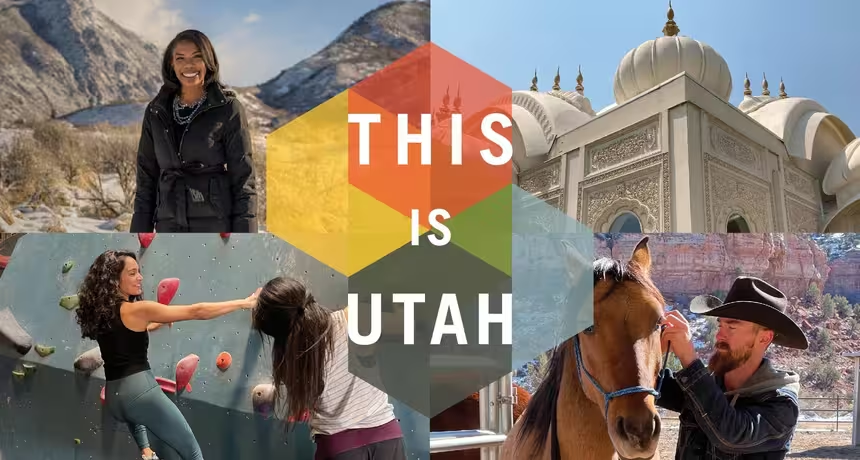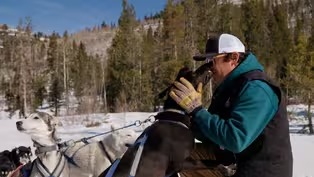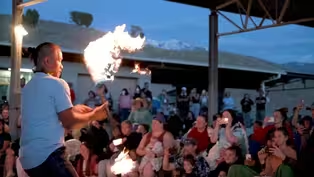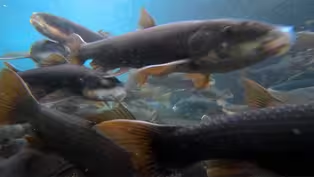
Pioneers of Aloha
Clip: Season 5 Episode 1 | 11m 15sVideo has Closed Captions
Discover a former settlement of Polynesian pioneers, a memorial and gathering place.
In Skull Valley, Utah, a former settlement of Hawaiian LDS pioneers stands preserved as a memorial and gathering place. The women of this community are dedicated to preserving its unique history and dispelling lingering myths. The land holds a captivating story, attracting Polynesian pioneers over a century ago and paving the way for a fast-growing community.
Problems playing video? | Closed Captioning Feedback
Problems playing video? | Closed Captioning Feedback
This Is Utah is a local public television program presented by PBS Utah
Funding for This Is Utah is provided by the Willard L. Eccles Foundation and the Lawrence T. & Janet T. Dee Foundation, and the contributing members of PBS Utah.

Pioneers of Aloha
Clip: Season 5 Episode 1 | 11m 15sVideo has Closed Captions
In Skull Valley, Utah, a former settlement of Hawaiian LDS pioneers stands preserved as a memorial and gathering place. The women of this community are dedicated to preserving its unique history and dispelling lingering myths. The land holds a captivating story, attracting Polynesian pioneers over a century ago and paving the way for a fast-growing community.
Problems playing video? | Closed Captioning Feedback
How to Watch This Is Utah
This Is Utah is available to stream on pbs.org and the free PBS App, available on iPhone, Apple TV, Android TV, Android smartphones, Amazon Fire TV, Amazon Fire Tablet, Roku, Samsung Smart TV, and Vizio.

This is Utah
Liz Adeola travels across the state discovering new and unique experiences, landmarks, cultures, and people. We are traveling around the state to tell YOUR stories. Who knows, we might be in your community next!Providing Support for PBS.org
Learn Moreabout PBS online sponsorship- As the sun rises above Skull Valley, we are shining a light on a piece of unique history about this land.
It's a place that beckoned Hawaiian pioneers more than 130 years ago, eventually paving the way for a community now growing faster than the State of Utah.
(lively Hawaiian drumming) (people clamoring) - To all outsiders, this is a ghost town.
That's why native Hawaiians have to tell this story.
I feel connected to this place because my people came here, they blessed this land with their care-taking.
My name is Kamaile Tripp-Harris, and this is a gathering place for my people.
(lively Hawaiian drumming continues) This is a Memorial weekend celebration that the Iosepa Historical Society puts on every year, and we have a camp out and there's a community lu'au.
Those things that we had established back home in Hawaii were reestablished.
The lu'au was what took place to reunite us and bring us back together, so that's why we do it here at Iosepa.
Iosepa means Joseph in Hawaiian and a lot of people think that it was named after the prophet Joseph Smith, but it wasn't.
It was named after his nephew, Joseph F. Smith, because he served a mission in Hawaii.
When Joseph F. Smith was 15, he, being an orphan, he was sent on a mission by the Church to Hawaii and while he was there, he got really sick, and a woman by the name of Manuhi'i nursed him back to life.
Their relationship would be the strong foundation that brought our people out here, and the reason that they came to this land.
(slow guitar music) (slow guitar music) (slow guitar music) - People wanna come.
They're drawn here, I think, being Hawaiian.
It's a source of real pride.
Humble pride though, ha'aha'a, is what we call it.
You always love where your people are, no matter where they are.
This is John Kauleinamoku.
He was one of the three Hawaiians on the committee that chose Iosepa for the people to live at.
And they loved this place because there was already a ranch, and there were some houses already there, and there was room for them to build more houses.
Our people back home are ranchers and farmers.
- [Kamaile] They knew what they were looking for.
They were looking for mountains that bear snow, 'cause they understand ecosystems and that that land would be their spring water, because these are all the things from our Native Hawaiian agricultural systems.
That's the knowledge they would've brought to Utah.
- And this is what President Hinckley said.
"This was not the desert we see today.
"This was once a beautiful community "and a part of a large mosaic of communities "that our people established all over the West, "and among them stood Iosepa as a gem, a paradise "brought from the islands of the Pacific "to the deserts of the West."
So, that was important to me to know, because everybody says they bought that land and just threw 'em out there.
I'm an amateur researcher, but when you love something so much, you just keep going.
You don't know how to do it, you don't know what you're doing, but you just keep collecting and collecting and somewhere, somebody's gonna say, "Let me tell you how to do this."
(gentle music continues) - Everybody finds their way to Iosepa in different ways and they feel inspired to come back here and then they keep coming back 'cause they feel a profound connection to it.
Spending time with Auntie Charmagne, you can't help but take on some of that responsibility, especially as a Hawaiian.
We call it kuleana.
It means responsibility, but also destiny.
Auntie's work here in the community has been so profound.
She wants us to know not just our language and symbols of our culture, but the deep meaning of it and how it connects us to our past and our future.
It's still a place where our people are and can be and provide that generational education and wealth for everyone.
Let's take a look.
(gentle guitar music) (gentle guitar music) Hannah Kaaepa, in 1899, speech to National Council of Women Iosepa resident urged support of women's voting rights efforts in the Territory of Hawai'i.
- We welcome all of our guests to Iosepa on this momentous occasion to honor our beloved kupuna Hannah Kaaepa.
We welcome the descendants who are led here by a special spirit whose kupuna lie in this sacred (speaks Hawaiian word), and once you come, you will never forget that spirit and you will seek it daily in your life.
Coming here makes you proud because you have this legacy, but to have have us reminded from time to time that we weren't just out here, we were out here doing something.
(gentle guitar music) - So this is the Salt Lake Herald from 1899.
You can see it gives a summary of Hannah Kaaepa's presentation in Washington DC.
- "One of the most interesting events "during the meeting of the National Council of Women "was the presentation to the Council of Hannah Kaaepa, "the young Hawaiian lady "who came here with the Utah delegation.
"She made a few remarks urging support "of ex-Queen Lili'uokalani "in her efforts to go to secure the ballot "for the women of Hawaii."
- Yeah, and Hawaii is just barely becoming a territory under the new government, and then they're fighting for women's rights to vote.
That's so cool!
- We had our first child here in Utah.
My mother flew over to help and then one of the first things she said to us is, "I want to go to Iosepa."
I went, "We don't know where that is."
So we had to drive up and down that Dugway Road.
And so we went in.
Hannah's mom, Makanoe, she's buried out there.
And so we thought, "Wow, we have pioneers here in Utah."
- When Hannah went to Washington, she fought for the rights of not only women to vote, but Native Hawaiian people.
The Native Hawaiian people who lived in the United States didn't have any voting rights and they weren't considered citizens of this country.
I think of Auntie Noe and Auntie Charmagne's success when I see this plaque.
("Nani Na Pua" by Queen Lili'uokalani) (Charmagne speaks in Hawaiian language) - The faithful women of Iosepa.
Yeah, that's our theme this year, because of Hannah.
It's time for people to know, because we were really, were a matriarchal society.
We thought our women were pretty cool.
I still do.
(Charmagne laughs) ("Nani Na Pua" by Queen Lili'uokalani) - You'll find when you search the internet that they say that Hawaiians abandoned Iosepa, but they didn't.
They really wanted to stay.
The generations had gone by long enough that the people who lived here were born here.
So Joseph F. Smith, when he gets sick and is dying, he wants to prepare the people for the coming future.
He tells them, "I won't be here."
He basically says, "I won't be here to advocate for you anymore."
- [Charmagne] And what he said, too, was, "When I'm gone, "they're not going to love you the way that I love you, "and I want to make sure that you're okay "and so I want you to go home."
- [Kamaile] They would've stayed here if they had the opportunity to, but the Church was selling the land and they were building a new temple so that they could go home to Hawaii and do the temple ordinances that they wanted to do here, now, in Hawaii.
- [Charmagne] Even so, it was with reluctance that they abandoned their beloved town.
Rosenberg quoted Alf Callister, a 12-year-old at the time as saying that "When the wagons were loaded to take the settlers away, "the women refused to ride.
"Instead, they walked the distance to the railroad station "and with big tears running down their faces, "kept looking back at their home "and uttering 'Goodbye, Iosepa, goodbye, Iosepa.'"
- Everything that the Native Hawaiian people had done from leaving Hawaii, trusting Joseph F. Smith, coming to Skull Valley where it got colder than a lot of these Hawaiian people ever experienced in their lives, it was all done on faith and ushering a better future for themselves and their family.
When we were here in May, there it was standing room only, almost.
It was so crowded.
It's because there were, literally, four or five generations of families here.
The descendants of Iosepa have continued to take care of the land and share its history with us.
I think a lot of us believe that we don't have pioneer ancestral roots because we're not descendants of those European ones.
But yeah, you have to come out to Iosepa (Kamaile chuckles) and you'll see that we were pioneers in our own right.
(energetic drumming) (people vocalizing jubilantly) (energetic drumming) Wow, so many vibrant colors and characters who warm my hearts simply by sharing their story.
And we want to hear your journey.
To chime in on this is Utah's Facebook, Instagram, and YouTube pages.
Hit the like button, share a comment, and don't forget to subscribe!
Until next time, I'm Liz Adeola and this is Utah.
Video has Closed Captions
Clip: S5 Ep1 | 9m 5s | A safe haven for humans and dogs, transforming lives and creating lasting connections. (9m 5s)
Preview: S5 Ep1 | 30s | Discover a connection between people, animals, and sanctuary in three compelling stories. (30s)
Video has Closed Captions
Clip: S5 Ep1 | 5m 4s | Rescuing the June sucker fish brings hope for the future of Utah's aquatic ecosystems. (5m 4s)
Providing Support for PBS.org
Learn Moreabout PBS online sponsorship
- Culture

Trace Adkins joins the US Army Field Band in "Salute to Service 2025: A Veterans Day Celebration."













Support for PBS provided by:
This Is Utah is a local public television program presented by PBS Utah
Funding for This Is Utah is provided by the Willard L. Eccles Foundation and the Lawrence T. & Janet T. Dee Foundation, and the contributing members of PBS Utah.




